John Hurrell – 11 December, 2009
Seeking work that was opinionated, inclined to agitation and direct, Newcall have approached nine artists who according to the blurb, have practices oriented towards 'activism or confrontation.'
Auckland
Comb a schooner like a comet.
Annie Bradley, Matthew Crookes, Peter Madden, Charles Ninow, Beth Orton, Ralph Paine, Martyn Reynolds, Daniel Webby, Tao Wells.
1 December - 19 December 2009.
Seeking work that was opinionated, inclined to agitation and direct, the Newcall curators for this exhibition have approached nine artists who according to the blurb, have practices oriented towards ‘activism or confrontation.’ At the same time, the curators are sensitive. They are cognisant of Free Will, that of the artists and their own in selecting them. So nothing can be assumed in terms of product.
That last bit is crucial because this is not really a placard waving show – though Tao Wells’ invitation of audience participation in placing photographs (with the word WAR) of the gallery neighbourhood in the gallery neighbourhood, and Ralph Paine’s large wall of paintings and drawings on paper, come closest to that lack of nuance in that their subject matter is obvious.
Wells’ project involves a box of 24 photocopied images of the gallery and the streets around it over which is placed WAR in bold yellow caps. He asks the viewer to either stick them up inside the gallery and/or outside, or to sell them as books. A couple ended up on Newcall walls, including one of some colourful birds placed over a power socket, folded so the word WAR was hidden. I didn’t spot any outdoor versions, except an Obama /Bush hybrid on the front door.
Ralph Paine’s wall-sized offering shows off his superb skills as an illustrator: images of jets, medieval battles, lots of explosions, curling waves, agonised skeletons and burning cities - the latter alluding to say, Beirut or Bagdad. All beautifully rendered in an understated fashion with no fine detail. And surprisingly for Paine – no text.
I didn’t see Peter Madden’s ‘para-performance’ on opening night – a found suitcase opened to reveal found photographs, but on a nearby wall is a small solitary photograph of what seems to be a group of sportsmen - maybe cricketers. A standing figure on the right has superimposed over half his body a military uniform, suggesting somebody killed in the Second World War.
Matthew Crookes has three works. One is a suite of sticky, peel-off letters that repeat the phrase In Loving Memory on a top corner of the glass front door. A second is a row on the floor of empty plastic book covers, all blood red. The third is a dessert spoon resting on a short piece of four by two. On its scoop are the stickered words: lick me disease.
Martyn Reynolds has a DVD presentation of a short looped film showing an old wooden chair standing in an empty field. It is projected onto a thin wall from an outside studio which when you look, contains the same chair holding the projector. The evocative flickering image is blue, that most poignant of colours; the chair a symbol for absence; the field perhaps a trope for European soil. We have pathos, yet a construction that is calculatedly knowing in its reflexivity.
Beth O’Brien’s single framed photograph of a young woman soldier struggling in a park to control an unwieldy, wind-dragged parafoil. Quiet Decisions, Specific Intentions seems to be an anti-military statement of considerable understatement, snorting at the notion of ‘managed’ intervention.
Uncontrollable process is showcased also in Daniel Webby’s installation, where a sloping ‘hammock’ of clear, wrinkled, cling film is suspended across the width of the gallery space between two towel holders. On it Webby has attempted to balance a gooey line of soaked dehydrated potato flakes, which has then fallen to the concrete floor. Attracting mould and smelling, the spud glop was later removed –though traces remain.
Annie Bradley contributes a two channelled video showing the artist and (I think) her father placing some household items in a trailer to be transported overnight. They need to be very securely tied down so they don’t slide around and get damaged. If you only know one knot… has one camera positioned on the van roof filming the trailer from above, while the other is partially aimed at a reflective window in the van’s door. The title advocates multiple approaches to problem-solving.
The last item is Charles Ninow’s sculpture that consists of two white trapezoid plywood forms on the floor. They seem to refer to the sloping eaves of a house and the demarcated proportions - measured out with steel brackets – of a sheet of a single bed. To speculate: the sheet in this context could be a shroud, and the ceiling, the ascension of a soul escaping from a corpse. An oblique and clinical, but also oddly evocative, work.
Shortly after writing and posting the above I was chatting to Dan Arps at Te Tuhi. He pointed out that the ‘steel brackets’ on the sloping upper surfaces of Charles Ninow’s work are in fact anti-skateboarding blockers - an allusion to social control and American foreign policy perhaps.
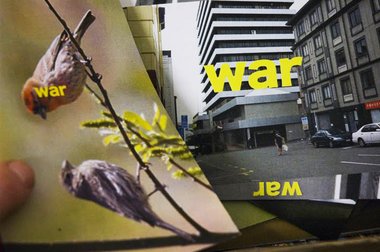
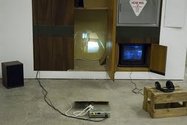

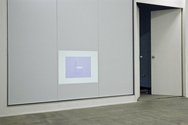
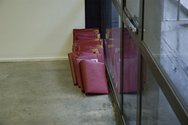
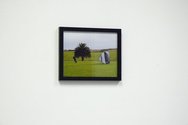
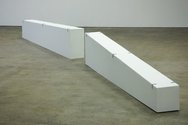
 Two Rooms presents a program of residencies and projects
Two Rooms presents a program of residencies and projects Advertising in this column
Advertising in this column



This Discussion has 0 comments.
Comment
Participate
Register to Participate.
Sign in
Sign in to an existing account.